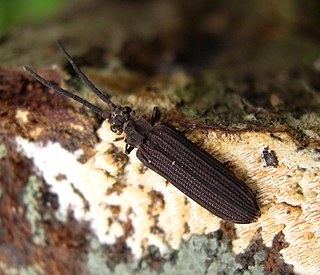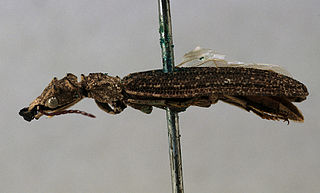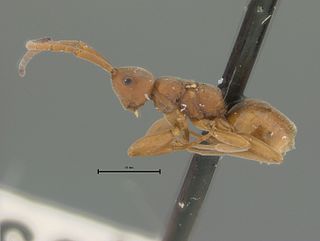
The Cupedidae are a small family of beetles, notable for the square pattern of "windows" on their elytra, which give the family their common name of reticulated beetles.

The Trachypachidae are a family of beetles that generally resemble small ground beetles, but that are distinguished by the large coxae of their rearmost legs. There are only six known extant species in the family, with four species of Trachypachus found in northern Eurasia and northern North America, and two species of Systolosoma in Chile and Argentina. They were much more diverse in the past, with dozens of described species from the Mesozoic.

Anaxyelidae is a family of incense cedar wood wasps in the order Hymenoptera. It contains only one living genus, Syntexis, which has only a single species, native to Western North America. Fossils of the family extend back to the Middle Jurassic, belonging to over a dozen extinct genera, with a particularly high diversity during the Early Cretaceous. Syntexis lay eggs in the sapwood of conifers, preferring recently burnt wood.

Evaniidae is a family of parasitoid wasps also known as ensign wasps, nightshade wasps, hatchet wasps, or cockroach egg parasitoid wasps. They number around 20 extant genera containing over 400 described species, and are found all over the world except in the polar regions. The larvae of these solitary wasps are parasitoids that feed on cockroaches and develop inside the egg-cases, or oothecae, of their hosts.

Hydrophiloidea, known as water scavenger beetles, is a superfamily of beetles. Until recently it included only a single family, the Hydrophilidae, but several of the subfamilies have been removed and raised to family rank. Hydrophiliidae remains by far the largest member of the group, with nearly 3,000 described species. The other families have no more than 400 species. The Histeroidea are closely related and sometimes considered part of a sensu lato Hydrophiloidea. The majority of the clade is aquatic, which is thought to be the ancestral ecology of the group, with some lineages like Sphaeridiinae becoming secondarily terrestrial. Modern representatives of the group first appeared during the Late Jurassic.

Coptoclavidae is an extinct family of aquatic beetles in the suborder Adephaga. The Coptoclavidae lived from the Late Triassic to the Early Cretaceous. Coptoclavidae is a member of the adephagan clade Dytiscoidea, which contains other aquatic beetles. Suggested reasons for their extinction to include the rise of teleost fish, or competition with Gyrinidae and Dytiscidae, which possess defensive secretions and sucking channels in the mandibles of larvae, which coptoclavids likely lacked. It has been suggested that the genus Timarchopsis and the subfamily Timarchopsinae are only distantly related to other coptoclavids based on cladistic analysis, with Timarchopsis being more closely related to geadephagans like carabids and trachypachids instead. Another study also suggested similarly for Coptoclavisca and possibly other coptoclaviscines.

The Ommatidae are a family of beetles in the suborder Archostemata. The Ommatidae are considered the extant beetle family that has most ancestral characteristics. There are only seven extant species, confined to Australia and South America. However, the geographical distribution was much wider during the Mesozoic spanning across Eurasia and Australia, suggesting that they were widespread on Pangea. So far, over 26 extinct genera containing over 170 species of these beetles have been described. Three extant genera have been assigned to this family: Omma,Tetraphalerus and Beutelius. The family is considered to be a subfamily of Cupedidae by some authors, but have been found to be more closely related to Micromalthidae in molecular phylogenies. A close relationship with Micromalthidae is supported by several morphological characters, including those of the mandibles and male genitalia. Due to their rarity, their ecology is obscure, it is likely that their larvae feed on deadwood.
Protorabinae is an extinct subfamily of beetles in the family Carabidae. It contains 36 species in 13 genera, all extinct.
Brochocoleus is an extinct genus of beetles in the family Ommatidae, known from the Early Jurassic to the Early Late Cretaceous. 9 species are currently recognised, with many species being reassigned to other genera by Kirejtshuk's major systematic revision in 2020.

Cionocoleus is an extinct genus of beetles in the family Ommatidae.

Omma is a genus of beetles in the family Ommatidae. Omma is an example of a living fossil. The oldest species known, O. liassicum, lived during the final stage of the Triassic (Rhaetian), over 200 million years ago, though the placement of this species in Omma has been questioned. Numerous other fossil species are known from the Jurassic and Cretaceous of Europe and Asia. The only living species is Omma stanleyi, which is endemic to Australia. Three other extant species endemic to Australia that were formerly part of this genus were moved to the separate genus Beutelius in 2020.Omma stanleyi is strongly associated with wood, being found under Eucalyptus bark and exhibiting thanatosis when disturbed. Its larval stage and many other life details are unknown due to its rarity. Males are typically 14–20 mm in length, while females are 14.4-27.5 mm. Omma stanleyi occurs throughout eastern Australia from Victoria to Central Queensland.

Mesoraphidiidae is an extinct family of snakeflies in the suborder Raphidiomorpha. The family lived from the Late Jurassic through the Late Cretaceous and is known from twenty-five genera. Mesoraphidiids have been found as both compression fossils and as inclusions in amber. The family was first proposed in 1925 by the Russian paleoentomologist Andrey Vasilyevich Martynov based on Upper Jurassic fossils recovered in Kazakhstan. The family was expanded in 2002 by the synonymizing of several other proposed snakefly families. The family was divided into three subfamilies and one tribe in a 2011 paper, further clarifying the relationships of the included genera.

Chresmoda is an extinct genus of insects within the family Chresmodidae.

Embolemidae is a family of small solitary parasitoid wasps with around 70 species in 2 genera distributed around the world. The few species whose biology is known are parasites on planthopper nymphs of the families Achilidae and Cixiidae. There is debate regarding the status of the genus named Ampulicomorpha by Ashmead in 1893, generally considered now to be a junior synonym of Embolemus (e.g.,), though some authorities dispute this (e.g.,)
Mesoblattinidae is an extinct, problematic family of cockroaches known from the Mesozoic. It was formerly considered a wastebasket taxon for Mesozoic cockroaches, but the family has subsequently been better defined, with many taxa transferred to Caloblattinidae. It is considered to have close affinities with Blattidae and Ectobiidae, as well as possibly Blaberidae. The family first appeared by the Early Jurassic. They are considered to represent amongst the oldest groups of modern cockroaches, and like them are thought to have laid oothecae.

Allophalerus is an extinct genus of beetle in the family Ommatidae. It is known from nine species formerly included in the genus Tetraphalerus.
Diluticupes is an extinct genus of beetle in the family Ommatidae.
Praeaulacidae is an extinct family of Mesozoic parasitic wasps in the suborder Evanioidea. It among the earliest known families of the group and is characterised by more complete wing venation in comparison to other members of the suborder. It has been found that Othniodellithidae is nested within Praeaulacidae via cladistic analysis.
Angarosphecidae is an extinct family of Mesozoic and early Cenozoic wasps in the superfamily Apoidea.

Notocupes is an extinct genus of medium-sized archostematan beetles from the Mesozoic Era of Eurasia, including over 50 described species. Historically, the genus was classified as a member of the family Ommatidae, but the presence of characters such as the horizontal mandibular cutting edge, separated procoxae and overlapping abdominal sternites indicate that the genus may have a closer affinity with the family Cupedidae. Notocupes is considered to be a junior synonym of Zygadenia by Kirejtshuk (2020), but other researchers suggest to reserve the genus Zygadenia as a form taxon for isolated elytra that probably belong to the genus Notocupes, while retaining Notocupes as a valid genus for complete body fossils. Most species of Notocupes were described from compression fossils. An additional three species were described from Cenomanian-aged Burmese amber, which were treated as a separate genus, Echinocups, by Kirejtshuk (2020), but Li et al. (2023) consider Echinocups to be a junior synonym of Notocupes. Notocupes has a flattened body, which may suggest that it occupied narrow habitats, such as living under bark. Some species had serrated/spined margins of the carapace, which may have served as a defense against predators, or served as camouflage to resemble bark.















